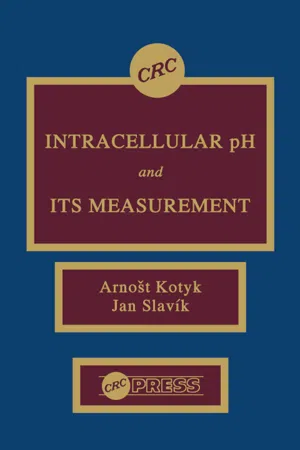
eBook - ePub
Intracellular pH and its Measurement
Arnost Kotyk,Jan Slavik
This is a test
- 192 pages
- English
- ePUB (mobile friendly)
- Available on iOS & Android
eBook - ePub
Intracellular pH and its Measurement
Arnost Kotyk,Jan Slavik
Book details
Book preview
Table of contents
Citations
About This Book
This volume introduces a summary of all the techniques used to estimate pH reliably. Emphasis is placed on the techniques that provide the most reliable and detailed data. The role of cell pH is explained with special emphasis on enzymology and membrane transport and bioenergetics. This book was written especially for molecular biologists, biochemists and biophysicists.
Frequently asked questions
How do I cancel my subscription?
Can/how do I download books?
At the moment all of our mobile-responsive ePub books are available to download via the app. Most of our PDFs are also available to download and we're working on making the final remaining ones downloadable now. Learn more here.
What is the difference between the pricing plans?
Both plans give you full access to the library and all of Perlego’s features. The only differences are the price and subscription period: With the annual plan you’ll save around 30% compared to 12 months on the monthly plan.
What is Perlego?
We are an online textbook subscription service, where you can get access to an entire online library for less than the price of a single book per month. With over 1 million books across 1000+ topics, we’ve got you covered! Learn more here.
Do you support text-to-speech?
Look out for the read-aloud symbol on your next book to see if you can listen to it. The read-aloud tool reads text aloud for you, highlighting the text as it is being read. You can pause it, speed it up and slow it down. Learn more here.
Is Intracellular pH and its Measurement an online PDF/ePUB?
Yes, you can access Intracellular pH and its Measurement by Arnost Kotyk,Jan Slavik in PDF and/or ePUB format, as well as other popular books in Scienze biologiche & Scienza generale. We have over one million books available in our catalogue for you to explore.
Information
Chapter 1
THE CONCEPT OF pH, HYDROLYSIS, AND BUFFERS
Arnošt Kotyk
TABLE OF CONTENTS
I. | Definition of pH |
II. | Ionization of Acids and Bases |
III. | Hydrolysis of Salts |
IV. | Buffering Power |
V. | The Activity Coefficient |
References | |
I. DEFINITION OF pH
Some 80 years ago, Sorensen introduced the symbol pH for the negative logarithm of concentration (moles or equivalents per cubic decimeter) of H+ ions.1 The letter “p” derives either from the Latin pondus (weight or significance) or from potentia (might or potential) and has since been used to denote the negative logarithm of concentration of various other ions; e.g., log cNa+ = −pNa, which is correct or at least consistent. It has also been used for the negative logarithms of various kinetic quantities having dimensions of concentration, such as the dissociation constant Ka, where −log Ka = pKa, which is certainly incorrect in the original sense of “p” but is useful in cases where sums or differences, such as pKa – pH, occur in formulae.
In Sörensen’s original version
(1) |
but it is now defined in terms of activities a. Thus (with γ being the activity coefficient),
(2) |
which, particularly in more concentrated solutions, represents an appreciable difference, as will be seen below.
It should be observed that in rigorous derivations of these equations both c and a (and, hence, γ) are dimensionless quantities that can be understood as concentrations or activities relative to a unit reference. Their values are thus numerically identical with true concentrations or activities expressed in moles per cubic decimeter.
Water, which is the principal milieu of all subcellular and cellular systems, is an extremely weak electrolyte; but it is still dissociated into ions, accordin...